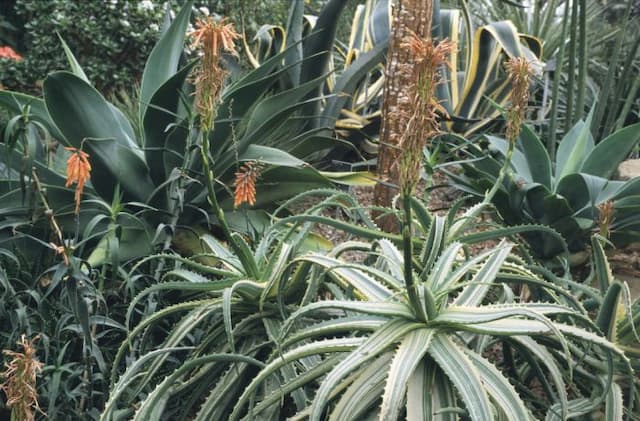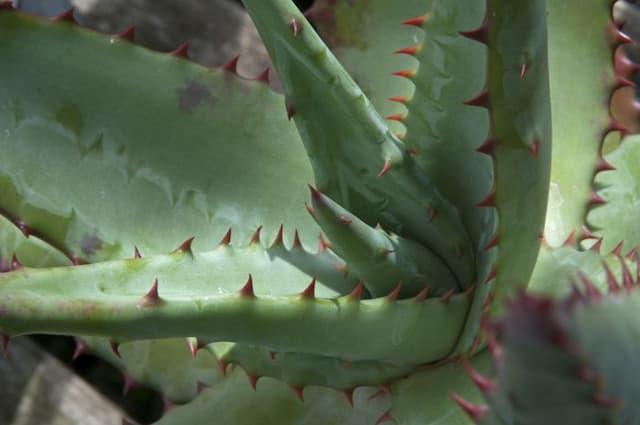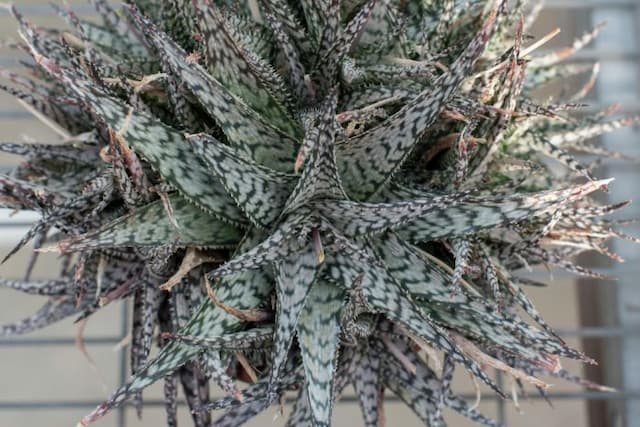Red Hot Poker Kniphofia 'Moonstone'

ABOUT
The Kniphofia 'Moonstone', also known as Red Hot Poker or Torch Lily, is easily recognized by its unique flower structure and vibrant coloration. The plant showcases a striking assemblage of tubular flowers that create a dense, elongated cluster at the top of a sturdy, upright stem. The flowers bloom in a gradient of warm colors, typically ranging from pale yellow to creamy hues, reminiscent of a glowing moonstone gem. These blooms artfully combine with the plant's grass-like foliage, forming a lush base of long, slender, and slightly arching leaves. The leaves are rich green in color, providing a contrasting backdrop to the illuminating flower spikes. As the blooms mature, the lower flowers may fade in color, while the tips maintain their brightness, offering a mesmerizing display. The plant's bold and dramatic flowers make it a favorite in ornamental gardens, where it adds vertical interest and a touch of exotic flair. The Red Hot Poker's ability to attract pollinators such as hummingbirds and butterflies to the garden adds an extra layer of dynamism to its presence. Despite the absence of specific size descriptors, the captivating appearance of the Kniphofia 'Moonstone' is sure to make a striking impression in any setting where it is planted.
About this plant
 Names
NamesFamily
Asphodelaceae
Synonyms
Red Hot Poker, Torch Lily, Poker Plant
Common names
Kniphofia 'Moonstone'.
 Toxicity
ToxicityTo humans
Red hot poker is generally not considered toxic to humans. However, like many plants, it can potentially cause irritation if the sap comes into contact with the skin or if any parts of the plant are ingested, particularly in individuals with plant sensitivities or allergies. Ingesting parts of the plant could lead to gastrointestinal discomfort such as nausea, vomiting, or diarrhea in some people, but this is not common.
To pets
Red hot poker is also generally considered non-toxic to pets. Nevertheless, consumption of the plant could lead to mild gastrointestinal upset, much like in humans. Symptoms like vomiting or diarrhea might occur if a pet ingests a significant amount of the plant, but serious toxicity is unlikely. Always monitor your pet's health and consult with a veterinarian if unusual symptoms occur after ingestion of any plant material.
 Characteristics
CharacteristicsLife cycle
Perennials
Foliage type
Evergreen
Color of leaves
Green
Flower color
Yellow
Height
3 feet (0.91 meters)
Spread
2 feet (0.61 meters)
Plant type
Herb
Hardiness zones
6
Native area
Africa
Benefits
 General Benefits
General Benefits- Ornamental Appeal: Kniphofia 'Moonstone', commonly known as Torch Lily, has striking flower spikes suitable for adding visual interest to garden landscapes.
- Attracts Pollinators: The vibrant blooms of Torch Lily attract bees, butterflies, and hummingbirds, thereby supporting local ecosystems.
- Drought Tolerance: Once established, Torch Lily is known for its ability to withstand periods of drought, making it suitable for water-wise gardens.
- Low Maintenance: It requires minimal care, with no need for frequent watering or trimming, making it a good choice for gardeners seeking low-maintenance plants.
- Long Blooming Period: Torch Lily provides a long season of color in the garden, with blooms lasting from late spring to early fall.
- Versatile Planting Options: It can be planted in borders, as a focal point in container gardens, or in mass plantings for a dramatic effect.
- Cold Hardy: Torch Lily can tolerate cold temperatures, making it suitable for growth in a variety of climates.
- Deer Resistance: The plant is not typically favored by deer, which can help prevent damage to the garden from grazing.
 Medical Properties
Medical PropertiesThis plant is not used for medical purposes.
 Air-purifying Qualities
Air-purifying QualitiesThis plant is not specifically known for air purifying qualities.
 Other Uses
Other Uses- Photography Subject: The striking appearance of Kniphofia 'Moonstone' flowers, with their gradation of colors, makes them a compelling subject for botanic and garden photographers.
- Thematic Gardens: Kniphofia 'Moonstone', commonly known as Red Hot Poker, is often used in fire-themed gardens to represent flames due to its fiery-colored blooms.
- Floral Arrangements: The tall, distinctive flowers of Red Hot Poker can add an exotic touch to floral arrangements and bouquets.
- Garden Sculpture Complement: These plants can be effectively placed near garden sculptures to draw attention with their bold, vertical lines and vibrant colors.
- Erosion Control: The root structure of Red Hot Poker can help stabilize soil and prevent erosion on slopes when planted in mass.
- Educational Tool: This plant can be used as part of educational programs in botanical gardens to teach about pollination, as it attracts hummingbirds and bees.
- Art Inspirations: The unique flowers of Red Hot Poker can provide artistic inspiration for painters and illustrators working on botanical subjects.
- Screening Plant: When grown in dense clumps, Red Hot Poker can provide a degree of privacy and act as a natural screen in the garden.
- Seasonal Marker: The blooming period of Red Hot Poker can be used as a phenological indicator, marking the progression of the growing season in a garden.
- Culinary Garnish: Although not a traditional use, the blooms could potentially be used as a dramatic, non-toxic garnish for special dishes in culinary presentations.
Interesting Facts
 Feng Shui
Feng ShuiThe Red Hot Poker is not used in Feng Shui practice.
 Zodiac Sign Compitability
Zodiac Sign CompitabilityThe Red Hot Poker is not used in astrology practice.
 Plant Symbolism
Plant Symbolism- Vitality and Life Force: The vibrant and fiery appearance of the Red Hot Poker, with its energetic spikes, embodies strong life energy and zest.
- Playfulness: With its whimsical and exotic shapes, the Red Hot Poker suggests a sense of fun and creativity, bringing a playful quality to gardens.
- Standing Out: As a plant with distinctive and bold flowers, the Red Hot Poker symbolizes the idea of being unique or standing out in a crowd.
- Attraction: The bright and showy flowers of the Red Hot Poker are known to attract hummingbirds and other pollinators, thus representing attraction and magnetism.
 Water
WaterRed Hot Poker or Torch Lily should be watered regularly, aiming for at least 1 inch of water per week, either from rainfall or manual watering. During the active growing season in the spring and summer, it may require more frequent watering, possibly even twice a week if the weather is particularly hot or dry. Ensure the soil is well-draining to prevent root rot but maintain consistent moisture. It's important to avoid overhead watering to prevent disease, and instead, water the plant at soil level. Over the winter months, watering can be reduced substantially to match the plant's dormant period.
 Light
LightTorch Lily thrives in full sun, needing at least 6 to 8 hours of direct sunlight a day to perform best. Plant it in a spot where it will receive unobstructed sunlight throughout the day. An area that is bright and sunny from morning to late afternoon is ideal for encouraging vibrant blooms and healthy growth.
 Temperature
TemperatureTorch Lily is hardy and can tolerate a wide range of temperatures. It typically thrives in temperatures above freezing and can survive in lows of around 20 degrees Fahrenheit. The ideal temperature range for this plant is between 50 and 85 degrees Fahrenheit. While it can withstand brief cold spells down to 20 degrees Fahrenheit, prolonged exposure to freezing temperatures should be avoided to prevent damage.
 Pruning
PruningTorch Lily should be pruned to remove spent flower stalks and encourage a second round of blooming. Dead or damaged foliage should be trimmed back in the spring. Pruning is also necessary in late fall or early winter after the plant has finished blooming and foliage has started to die back. At this time, cut the foliage down to about 3 inches above the ground to prepare the plant for dormancy.
 Cleaning
CleaningAs needed
 Soil
SoilRed Hot Poker 'Moonstone' thrives in well-draining, fertile soil enriched with compost or well-rotted manure. The best soil mix should consist of a blend of garden soil, compost, and sharp grit to improve drainage. The ideal pH range for Red Hot Poker is between 6.0 and 7.0, slightly acidic to neutral.
 Repotting
RepottingRed Hot Pokers, including 'Moonstone', are typically not repotted often as they prefer to be left undisturbed. They may only need repotting every 3 to 5 years, preferably in the spring, as long as they are not overcrowded in their current space.
 Humidity & Misting
Humidity & MistingRed Hot Poker 'Moonstone' is tolerant of a range of humidity levels and does not require special atmospheric humidity conditions to thrive. It is more important to maintain proper soil moisture than to provide a specific humidity level.
 Suitable locations
Suitable locationsIndoor
Provide bright light and well-draining soil for indoor Red Hot Pokers.
Outdoor
Plant in full sun, well-drained soil, and space them about 18 inches apart.
Hardiness zone
6-9 USDA
 Life cycle
Life cycleKniphofia 'Moonstone', commonly known as Red Hot Poker or Torch Lily, begins its life cycle as a seed, which sprouts to form seedlings when provided with the right conditions of warmth and moisture. The seedlings grow into rosettes of narrow, strap-like leaves, establishing a strong root system. As the plant matures, it develops a sturdy flower stalk that rises above the foliage, bearing dense spikes of tubular flowers that can range from creamy white to pale yellow. After pollination, primarily by hummingbirds and bees, the flowers set seed. The plant may die back in winter, especially in colder climates, but with its perennial nature, it will regrow from its roots in the spring. Over time, the plant can be divided to propagate new individuals and maintain vigour.
 Propogation
PropogationPropogation time
Late Spring - Early Summer
Propogation: Kniphofia 'Moonstone', commonly known as the torch lily or red hot poker, is often propagated by division. The preferred time for dividing torch lilies is in the spring when new growth begins to emerge. To propagate by division, one should carefully lift the clump from the ground with a spade, making sure to keep a good amount of root system intact. Once lifted, use a sharp knife or spade to cut through the root ball, ensuring that each section has at least one growth point. Replant the divisions promptly into well-draining soil, placing them at a depth similar to their previous growing conditions. The divisions should be spaced about 18 to 24 inches (approximately 45 to 60 centimeters) apart to allow for mature growth. Water the newly planted divisions well to help establish them. This method allows the gardener to increase their stock of Kniphofia 'Moonstone' while also rejuvenating older clumps that may have become too dense.









